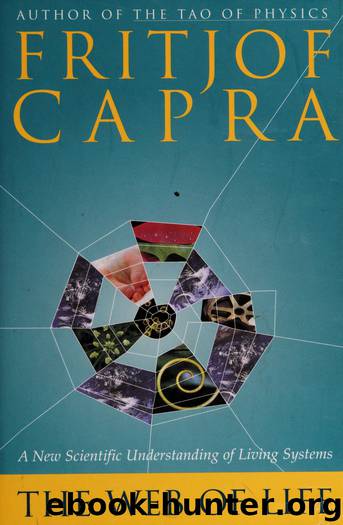The web of life : a new scientific understanding of living systems by Capra Fritjof

Author:Capra, Fritjof
Language: eng
Format: epub
Tags: Life (Biology), Biological systems, System theory, Biological Sciences, Systems Theory, Sistemas biológicos, Teoría general de sistemas, Ecologie, Maatschappij, Ethiek
ISBN: 0385476760
Publisher: New York : Anchor Books
Published: 1996-08-05T16:00:00+00:00
181
classical science that we run into difficulties with conventional language. Dictionary definitions of the word “stable” include
fixed,” “not fluctuating,” and “unvarying,” all of which are inaccurate to describe dissipative structures. A living organism is characterized by continual flow and change in its metabolism, involving thousands of chemical reactions. Chemical and thermal equilibrium exists when all these processes come to a halt. In other words, an organism in equilibrium is a dead organism. Living organisms continually maintain themselves in a state far from equilibrium, which is the state of life. Although very different from equilibrium, this state is nevertheless stable over long periods of time, which means that, as in a whirlpool, the same overall structure is maintained in spite of the ongoing flow and change of components.
Prigogine realized that classical thermodynamics, the first science of complexity, is inappropriate to describe systems far from equilibrium because of the linear nature of its mathematical structure. Close to equilibrium—in the range of classical thermodynamics—there are flow processes, called “fluxes,” but they are weak. The system will always evolve toward a stationary state in which the generation of entropy (or disorder) is as small as possible. In other words, the system will minimize its fluxes, staying as close as possible to the equilibrium state. In this range the flow processes can be described by linear equations.
Farther away from equilibrium, the fluxes are stronger, entropy production increases, and the system no longer tends toward equilibrium. On the contrary, it may encounter instabilities leading to new forms of order that move the system farther and farther away from the equilibrium state. In other words, far from equilibrium, dissipative structures may develop into forms of ever-increasing complexity.
Prigogine emphasizes that the characteristics of a dissipative structure cannot be derived from the properties of its parts but are consequences of “supramolecular organization.” 6 Long-range correlations appear at the precise point of transition from equilibrium to nonequilibrium, and from that point on the system behaves as a whole.
182
THE WEB OF LIFE
Far from equilibrium, the system’s flow processes are interlinked through multiple feedback loops, and the corresponding mathematical equations are nonlinear. The farther a dissipative structure is from equilibrium, the greater is its complexity and the higher is the degree of nonlinearity in the mathematical equations describing it.
Recognizing the crucial link between nonequilibrium and nonlinearity, Prigogine and his collaborators developed a nonlinear thermodynamics for systems far from equilibrium, using the techniques of dynamical systems theory, the new mathematics of complexity, which was just being developed. 7 The linear equations of classical thermodynamics, Prigogine noted, can be analyzed in terms of point attractors. Whatever the system’s initial conditions, it will be “attracted” toward a stationary state of minimum entropy, as close to equilibrium as possible, and its behavior will be completely predictable. As Prigogine puts it, systems in the linear range tend to “forget their initial conditions.” 8
Outside the linear region the situation is dramatically different. Nonlinear equations usually have more than one solution; the higher the nonlinearity, the greater the number of solutions.
Download
This site does not store any files on its server. We only index and link to content provided by other sites. Please contact the content providers to delete copyright contents if any and email us, we'll remove relevant links or contents immediately.
| Anatomy | Animals |
| Bacteriology | Biochemistry |
| Bioelectricity | Bioinformatics |
| Biology | Biophysics |
| Biotechnology | Botany |
| Ecology | Genetics |
| Paleontology | Plants |
| Taxonomic Classification | Zoology |
Sapiens: A Brief History of Humankind by Yuval Noah Harari(14250)
The Tidewater Tales by John Barth(12608)
Mastermind: How to Think Like Sherlock Holmes by Maria Konnikova(7227)
Do No Harm Stories of Life, Death and Brain Surgery by Henry Marsh(6890)
The Thirst by Nesbo Jo(6826)
Why We Sleep: Unlocking the Power of Sleep and Dreams by Matthew Walker(6618)
Life 3.0: Being Human in the Age of Artificial Intelligence by Tegmark Max(5474)
Sapiens by Yuval Noah Harari(5294)
The Longevity Diet by Valter Longo(5019)
The Body: A Guide for Occupants by Bill Bryson(4974)
The Rules Do Not Apply by Ariel Levy(4859)
The Immortal Life of Henrietta Lacks by Rebecca Skloot(4525)
Animal Frequency by Melissa Alvarez(4395)
Why We Sleep by Matthew Walker(4360)
The Hacking of the American Mind by Robert H. Lustig(4318)
Yoga Anatomy by Kaminoff Leslie(4305)
All Creatures Great and Small by James Herriot(4232)
Double Down (Diary of a Wimpy Kid Book 11) by Jeff Kinney(4207)
Barron's AP Biology by Goldberg M.S. Deborah T(4097)
